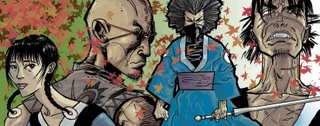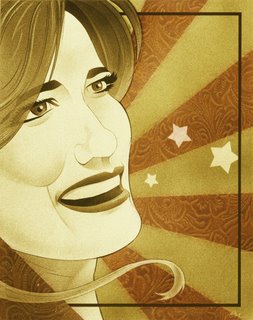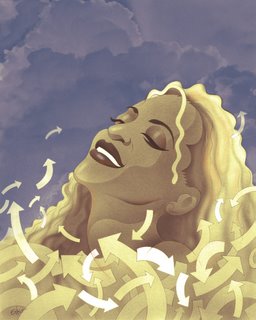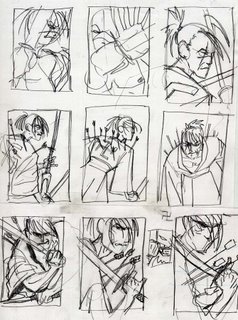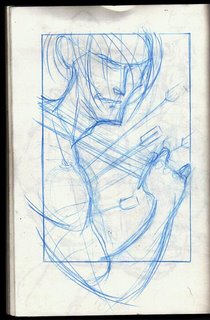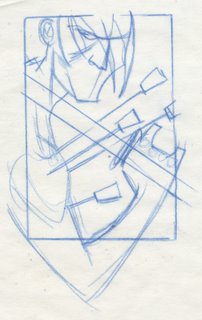
A while ago, when I started teaching Illustration, I realized that while some of my students wanted to become illustrators, others were planning on going into design. I also realized how at times younger art directors, and a few older, seemed at a loss as to how to direct art and work with illustrators. In school you’re taught to be an illustrator or designer, but not how to work with one another. So, I asked a few art directors I knew, who worked well with Illustrators, if they had any rules for art direction. What follows are their answers.
I plan to expand on this and collect as many rules as I can from other art directors and illustrators. If you have any comments about this post, or rules of your own, feel free to chime in.
The relationship between the art director and illustrator can make or break both the design and the illustration. It’s a living thing that holds the potential to create great work. It’s a part of the business that seems to get little attention in schools and in real life. I think we can change that.
Live fast, draw hard.
-----------------------------------------------------------
Florian Bachleda
Vibe Magazine
Well, a lot of it depends on who the illustrator is. In many ways I’ve always considered the AD/Illustrator relationship to be like that of the film director and actor. If you’re a good director, you tailor how you deal with the illustrator, depending on their talent, temperament and strengths. Overall the director should point where he or she wants to go and what solution needs to be solved, then leave the rest to the illustrator. Here’s point A and point B, take me there. If you don’t trust your Illustrator, you shouldn’t have picked them. This is assuming there is not an overbearing editor somewhere who can ruin the process entirely—no matter how good the AD and Illustrator are.
Half the battle is choosing the right Illustrator- and not always the most obvious- for the assignment. At
New York Magazine, Bob always had us choose an illustrator that didn’t automatically come to mind. For example, we would have Steve Brodner do concept illos, and Sue Coe do likenesses. Again, The editor is the most important factor here—if they’re brave enough and trust their AD to work like this.
An illustrator should never, ever call up an art director and ask him or her for information such as the address of the magazine, the spelling of the art director’s name, who else is in the department, etc. Basically, any information the illustrator can get on their own from some basic research (picking up the magazine and looking at the masthead, address, etc,) It may sound snooty, but to me it says this illustrator is unprepared.
----------------------------------------
Katherine Topaz
Topaz Design
1. Don’t assume anything. Be clear. Use specific language, i.e. don’t say "Okay, you want it to look 'hip', " say, “Okay, when you say hip you mean like…”
2. Sometimes art directors have no clue what they want and they want you the illustrator to come up with something, but art directors usually have something in mind. Make sure you understand which is the case. If the art director wants you to come up with the concept, make sure that is clear what they are asking for, because obviously you are more vulnerable for the amount of alterations needed. If the art director knows what he wants, then, listen, ask questions, be clear and specific.
3. Art directors want to give criticism. Make them feel comfortable by not being defensive. The more the art director feels comfortable, the more the art director will give—which is good, because the more they talk, the more specific and clear they are, and the happier you are with the end result. The easier the process is, and the more comfortable the art directors are with the process the more they want to use you again—or recommend you.
4. Don’t assume art directors know all of your styles if you have multiple styles. Send samples. When art directors talk about “your style” make sure sure you know which “style” they are talking about. Many art directors think of illustrators as having one style, the one the art director is familiar with. Thusly they expect that style when they assign work. The art director might not assign other projects because he doesn't know the illustrator can do that style. On the other hand, the art director won’t assign a project because he knows the illustrator will try to “talk them into” their other style which the art director may not like.
5. Remember the art director is more aware than you of internal politics. For example: if the editor likes or hates illustrations. Sometimes this means the art director knows what types of illustrations can be used in order to get more in the future. Or what styles/elements/ colors set the owner/client off. See #1.
6. Don’t assume they don’t like your work because they haven’t used you. It might be a situation where they’re waiting and hoping, months (and yes, years) might go by. Make sure you continue to send samples and keep your contact number, email and address information current.
7. Do not bother them. Again, you have no clue what’s going on at their end. So contact them in non-threatening ways. E-mail is good. You can call, but be aware of their deadlines, press days, etc.
-------------------------------
Bob Newman,
Fortune
It’s funny, because my only philosophy is to call the right people, people I like and like working with, and give them as much freedom as possible. If there’s anything I can say that works best from my end is that an art director be as clear as possible about what’s wanted stylistically and content-wise. I try to give some direction in terms of the illustrator’s style, especially if they have multiple approaches (which many do). I also try to suggest they send a few sketches…I usually say, “Do your thing, send whatever you want for sketches, but also do something relatively straight-forward for the editor.” It’s great for me to get a few options, let the illustrator stretch out, but also have something safe. The other thing I try to do is let them know when the illustration really needs to fit the design of the page: it needs a background, it should be a silhouette, the size and shape really matters. And on the flip side, when the page is more free-form, I like to tell them, let me know what shape works best for you. I always try to think out trouble spots ahead of time, and really work hard to find an illustrator who is just perfect for the assignment.
I think it’s important to let illustrators know that they should be realistic about their talents and skills and who they approach for work. I see a lot of illustrator books that are sent to a magazine that would never publish work in their style. Also, a lot of illustrators rush out and show their book to people way too early, before they have skills and experience necessary to work for that magazine. The problem with this is that you may only get one chance to show or drop off your book somewhere, and it doesn’t help you if it’s not together. You’re better off hustling at smaller, less prestigious places where you might actually get work that can build up your book and your experience. Some tear sheets from
The Village Voice or
Guitar World are better than a rejection from
Rolling Stone.
Art directors like to see illustrations with ideas, or style, or great caricatures. But most of all style. The most important thing for a young illustrator to work on are style, technique and ideas. The interesting thing is that all art directors have different approaches…some would rather see more style, others more ideas.
Nothing beats professionalism. Anyone who wants to get work as an illustrator needs the basics: email, message machine, fast reply to phone calls, fax, etc. From a practical point of view, it really helps to get gigs if you work digitally or can transmit your work digitally.
---------------------------------------
Jesse Marinoff Reyes,
Penguin USA
1) What can I say? First off, I don’t mean to state the obvious (but I will anyway), is that art directors (ADs) and future ADs should always be
clear with their illustrators. Too often, there is a lack of clarity which generally implies that the illustrator should “do their thing” but this lack of clarity may not mean this. It may merely mean that the AD is not a good communicator (despite egotistical leanings to the contrary). It could also mean that the AD is unsure of what’s expected by his superiors (and editor, or a publisher—or in my case—an author and the author’s agent). Because time is finite, clarity in instruction can prevent unnecessary delays and prevent misunderstanding.
ANECDOTE: I know this because I have been put in a position a number of times in the past to second-guess another AD when an illustrator pal gets confused at the 11th hour, when they can't contact their art director.
2) ADs need to have an air of authority in their presentation to the illustrator. If the illustrator doesn’t believe this, the deadline can become jeopardized by a careless illustrator and an AD who is too distracted to notice until it is too late. The criteria in #1 is helpful in this, but I would also add that the AD knows how much finite time exists between the submittal of art and the time it takes to design around it in time to make the press deadline. Sometimes illustrators have some leeway (as in formatted magazine pages) to turn in work closer to the printing deadline, but again, this discretion is up to the art director and no one else. The illustrator has to understand that part of their being contracted to work has to do with their ability to get the job done on time.
ANECDOTE: An illustrator I knew of became too comfortable with the amount of time allotted for revision, and came to believe that art directors gave “fake” deadlines. The deadlines were certainly not “fake,” but the illustrator made the mistake of arrogantly taking the time for himself without permission (turning in the artwork later than scheduled). The illustrator’s livelihood depends upon the level of trust that the AD has in him. Without that trust, there is no relationship—and no work.
3) The AD needs to know “what’s going on” in the art and design and illustration world. If an AD wants to work with certain illustrators, he needs to learn about them (if possible). Their style, their body of work, their reputation. The annuals are a good place to start, but only as a point of departure. Sometimes the best illustrators are not the folks you find in award books. Does the AD’s body of work mean that to execute his particular vision at a particular workplace at a particular time mean that the AD needs to suss out his own brand of illustrator? Maybe he only wants to work with underground cartoonists, or classically-trained illustrator-painters. Maybe the one category was great for that AD's philosophy for the first 5–8 years
of his career, but the next job demanded a different vision and he had to become familiar with the latter style and it’s adherents. Maybe it’s good to be AWARE period. Knowing what other art directors are doing is also helpful, but it can lead to “Flavor of the Month” syndrome—where everyone seems to be working with a particular guy all at the same time. Is this because that illustrator is “hot” ( I really hate that) or really because “everyone else is using him.” But does any of that mean the illustrator is any good or not? Gee whatever became of “so-and-so…”
ANECDOTE: This is especially useful in determining which illustrators are suited to a particular job. Or how illustrator “A” should be handled versus illustrator “B” on the same kind of job. For example, some illustrators are great conceptually. Some have superb design skills within an illustration context. Others have great style and technique, yet don’t want to have to think beyond a certain point whereas others thrive on the “stretching. Glenn Hilario is a good “stretcher.” He can place himself into a design context. Scott McDougall prefers to be told what he needs to do and what he’s being fit into. It’s not that the one is superior to the other (sometimes you want somebody who just wants to take direction; sometimes you need all the help you can get), it’s just that knowing these differences can help in a particular context, solving a particular problem or set of problems.
4) It’s helped in my case that I’d spent time as an illustrator during my career. This is not an absolute requirement to be a good art director, but it helped in my case. I kinda knew if someone was begging for more time because he really needed it—or because he’d blown off the deadline until it was too late. At times former-sometime-illustrators can tend to impose their personal style preferences on an illustrator (I’ve seen this), in other words, use the illustrator as a “wrist.” I’d caution any future ADs with illustration backgrounds to have more respect for the actual talent doing the actual work. Let that background help the AD/illustrator relationship—not hinder it.
5) Be AWARE. Not as in criteria #3 per se with illustrators and their work, but culturally, socially, politically, historically. Read. Know about things. Being a cypher is fine, but it can only take you so far in problem solving.
Let the illustrator BE who they are. What does this mean? part of the AD process is picking certain talent to solve certain problems. For example, if a collage artist is selected, it should be because of that artist’s ability to create an arresting image through collage—but some bad AD’s or “others” in the food chain will use that as an excuse to force the collagist to find
every element of the story and cram it into the image (I’ve been in this unfortunate situation as an illustrator). Understanding that certain illustrators and/or certain styles are desired to solve a problem, it’s in the best interests of everyone concerned that the AD be sure about this approach—and then let the talent thrive in the situation. Knowing that Steve Cerio is great with counterculture imagery helps in just turning over those kinds of assignments to him, and letting him “do his thing.” This, of course, has a lot to do with criteria #1 above (clarity), but when you are sure of this then the process can become sublime. Contrarily, if you hire a Gary Panter to render an assignment better suited to Bernie Fuchs, then the result (and the political fallout) will not be pleasant for anyone concerned—and because the AD should’ve known better (and didn’t act or think), the relationship is soured. Sometimes this is because the AD is too embarrassed to contact the illustrator again after a bad experience, even if it’s not the “fault” of the illustrator.
